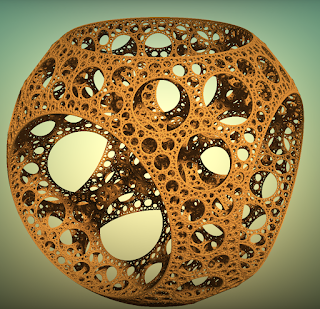Void-sponges are probably the easiest self-siimilar shape to make with inversive geometry, but it isn't obvious whether there is a particular shape that is somehow a better archetype than others; something that is 'the canonical inversive void-sponge'.
It does exist and there are six of them. The trick is to realise that the most symmetric 3D structure is a 3-sphere, and that regular polychora (4D polyhedra) have evenly distributed vertices on the 3-sphere.
We therefore run the iterative inversions in 4D with sphere inversion centres at the polychora vertices, then stereographically project them back into 3D. This projection is conformal and Mobius so spheres remain as spheres. Any such projection will do, but in practice there is one that mimimises the object size by placing the pole on the face centre (farthest from the vertices), this also has rotational symmetry in 3D so is the best choice. Noting that it is structurally the same shape regardless of the Mobius transformation, and these inversive shapes should always be considered as equivalence classes under not just similarity transformations but also Mobius transformations.
So the six shapes come from the six regular polychora, the 5-cell:
The other free parameter is whole number n where the intersection angle between spheres is 180/n. For large n we get sparser shapes like above. And for smaller n they are thicker like below.There is also the 8-cell:
16-cell:










No comments:
Post a Comment